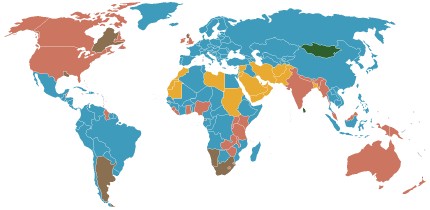
About Andrew Cusack
 Writer, web designer, etc.; born in New York; educated in Argentina, Scotland, and South Africa; now based in London.
Writer, web designer, etc.; born in New York; educated in Argentina, Scotland, and South Africa; now based in London. read more
News
Blogs
Reviews & Periodicals
Arts & Design
World
France
Mitteleuropa
Knickerbockers
Argentina
The Levant
Africa
Cape of Good Hope
Netherlands
Scandinavia
Québec
India
Muscovy
Germany
Academica
The World of Law


Today I stumbled upon this nifty little map (slightly modified) on Wikipedia showing the different legal systems of the world. (Click on the map above for the full version). Civil law is predominant, but of course Common Law is the best, and happens to predominate throughout the English-speaking world. Four economists have also claimed that economic prosperity and the common law system are linked. As one can see from the map, Scotland does not share the same legal system as the rest of the United Kingdom but instead has its own unique system of law, the maintenance of which was stipulated in the 1707 Treaty of Union uniting Scotland and England.
The Wikipedia article on Common law has a paragraph on New York law, which interestingly states:
To be specific, the patroon system ended along with the later manorial courts originating from the British period when New York abolished these psuedo-feudal law features in 1849. Scarsdale, the neighboring municipality to the north of here, is supposedly the last manor granted in the British Empire and recently celebrated the three-hundredth anniversary of the 1703 grant. There were a number of other manors granted in New York, such as Fordham and Pelham nearby. The City of New Rochelle consists of land purchased by the Huguenots from Thomas Pell. One of the stipulations was that New Rochelle would present Pell and his successors with a fatted calf every year on St. John’s Day (if my memory serves me correctly). I understand the practice was continued into the 20th century before sadly lapsing.
Meanwhile, some Europeans are catching on to the fact that the Supreme Court of the United States has usurped legislative powers contrary to the Constitution. The Chancellor of Austria and Prime Minister of Denmark are worried that the European Court of Justice might be tempted to do the same, and Paul Belien offers his thoughts at the Brussels Journal.
Search
Instagram: @andcusack
Click here for my Instagram photos.Most Recent Posts
- Bicycle Rack April 29, 2024
- Burns Tower April 19, 2024
- Patrick in Parliament March 18, 2024
- Articles of Note: 13 March 2024 March 13, 2024
- Cambridge March 9, 2024
Most Recent Comments
Book Wishlist
Monthly Archives
Categories


